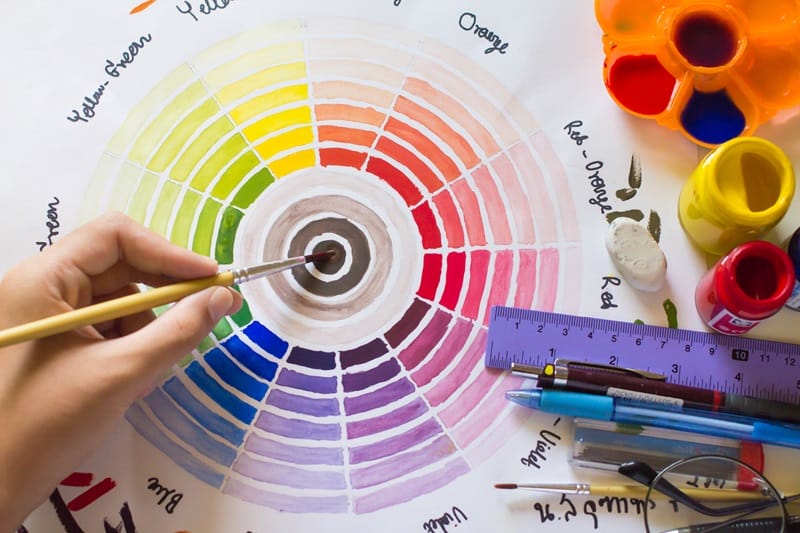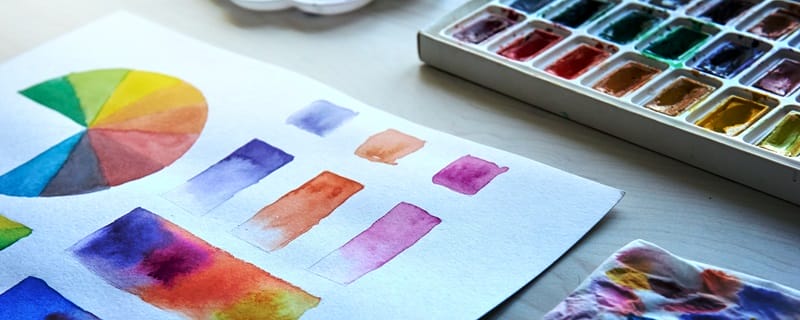
Final up to date: June 11, 2024 by Amanda
Love artwork? Do you need to be taught all about complementary colours? Effectively, you’ve come to the fitting web page when you’re a complete noob with regards to coloration, and also you surprise “Does mustard yellow go together with neon orange”? Whether or not you’re a curious child, a artistic guardian, or a devoted artwork instructor, this weblog has been written only for you.

We’re diving into all of the enjoyable information on the colour wheel, exploring what makes reverse colours, and unlocking the secrets and techniques of the complementary coloration wheel too. We have additionally supplied you three free coloration wheel printables to reference all through your inventive experimentations. Shade is an integral a part of artwork, and utilizing colours that go nicely collectively is SO necessary. Understanding what colours work nicely collectively may even be helpful for selecting out garments! Seize your paintbrushes and get experimenting.
What are Complementary Colours?
The easy reply is: Complementary colours are pairs of colours which are discovered reverse to one another on the colour wheel. When positioned subsequent to one another, these colours create a surprising distinction, which makes every coloration pop.
A couple of IRL examples of complementary colours at work are sunsets with fiery oranges and deep purples, seashores with beige sand and a greenish-blue ocean or forests of lush greens and wealthy red-browns.
Free Printable Shade Wheel to Obtain
First issues first! Obtain your free printable coloration wheel to make it simpler to observe alongside as we get into the idea. To not point out, you’ll be able to maintain it to reference throughout your coloring adventures!
These printables are for private, non-commercial use solely.
What Does Shade Principle Imply?
Right here’s the science bit – Shade principle is the precise science and artwork of utilizing coloration. It helps us perceive how colours work together, how they are often combined, and the way they are often mixed to create picture-perfect designs. The colour wheel is an important instrument in coloration principle, serving to us to visualise the relationships between colours. By understanding coloration principle, we will create stunning work, design eye-catching posters, and even select the proper outfit!
Mixing Complementary Colours
In case you love science – you’ll love this! Mixing complementary colours might be an thrilling experiment. If you combine two complementary colours, you’ll get a impartial coloration like grey or brown. This occurs as a result of the colours cancel one another out. For instance, mixing crimson and inexperienced paint provides you with a brownish coloration. It is a enjoyable solution to discover the science of coloration and see how totally different hues work together with one another.
Primary Complementary Colours
Are you able to see them? The fundamental complementary colours are simple to spy on the colour wheel. These pairs embrace crimson and inexperienced, blue and orange, and yellow and purple. Every pair consists of a major coloration (crimson, blue, yellow) and the secondary coloration straight reverse it. These fundamental pairs are the constructing blocks of the complementary coloration wheel and supply a basis for creating vibrant, contrasting designs.

The best way to Use Complementary Colours
Now you understand all about complementary colours, you should use them with model. Utilizing complementary colours could make your paintings, designs, and even your own home décor pop. Listed below are a number of suggestions:
In artwork, remember to use complementary colours to focus on eye-catching parts in your portray or drawing. For instance, a vivid orange sundown in opposition to a deep blue sky will draw the attention.
In design, complementary colours are nice for creating attention-grabbing posters and even web sites. For instance, a crimson button on a inexperienced background will stand out and make you need to click on it.
In vogue, carrying complementary colours can actually make your outfit pop. The experimenting is a lot enjoyable! Strive pairing a blue costume with orange equipment for a very daring look.
Continuously Requested Questions About Complementary Colours
Nonetheless eager to know extra? Perhaps a few of these FAQs will assist!
What are the 6 Pairs of Complementary Colours?
Let’s start with the fundamentals! Every pair of colours combines a major coloration with the secondary coloration that is reverse to it on the colour wheel. These coloration combos create gorgeous contrasts. The six foremost pairs of complementary colours are:
- Pink and Inexperienced
- Blue and Orange
- Yellow and Purple
- Pink-Orange and Blue-Inexperienced
- Yellow-Inexperienced and Pink-Purple
- Blue-Purple and Yellow-Orange
What are the 12 Complementary Colours?
Delving a bit deeper than the six fundamental pairs, the 12 complementary colours embrace tertiary colours, that are simply created by mixing a major coloration with a secondary coloration. These pairs add extra depth to your coloration palette, permitting for a lot of extra artistic potentialities. Right here they’re:
- Pink and Inexperienced
- Blue and Orange
- Yellow and Purple
- Pink-Orange and Blue-Inexperienced
- Yellow-Inexperienced and Pink-Purple
- Blue-Purple and Yellow-Orange
- Pink-Purple and Yellow-Inexperienced
- Blue-Inexperienced and Pink-Orange
- Yellow-Orange and Blue-Purple
- Inexperienced-Blue and Pink-Orange
- Orange-Yellow and Blue-Purple
- Purple-Pink and Yellow-Inexperienced

What are the Complementary Shade Tones?
Okay, so complementary coloration tones contain totally different shades, tints, and tones of the complementary pairs. These shades are created by mixing black right into a coloration, making it darker. Tints are made by including a bit white, making the colour lighter. Tones are achieved by including grey, making a softer type of the colour. Utilizing totally different tones of complementary colours can add depth and curiosity to your artsy designs.
What are the 4 Shade Complementaries?
The 4 coloration complementaries refer to 2 pairs of complementary colours when used collectively. This system can create a balanced look whereas nonetheless giving a vibrant distinction. For instance:
Utilizing 4 coloration enhances collectively can typically be a bit bit difficult, nevertheless it may end up in gorgeous designs. One of the simplest ways is to experiment and see for your self how totally different combos of colours work collectively.
Mixing Colours with Shade Principle
Now that you’ve learn our weblog, you could have a brand new superpower! Understanding and utilizing complementary colours is crucial on the planet of coloration. Whether or not you’re portray a masterpiece, or designing a poster for college, and even choosing out an outfit, understanding the right way to use the complementary coloration wheel will help you create eye-catching artworks.
Seize your coloration wheel, and let your creativity run wild with the magic of complementary colours.
Oh, and when you’re nonetheless questioning if mustard yellow goes with neon orange, the reply is not any!
Complementary Colors
Red and Blue Make Purple
Mixing Blue and Pink
Green and Yellow Make
Blue and Green Make
Pink and Green Make
What Does Orange and Blue Make?
Red and Green Make Brown
What Color Does Green and Orange Make?
Purple and Yellow Make Mauve
Red and Purple Make
Trending Merchandise











